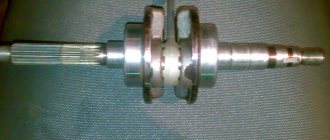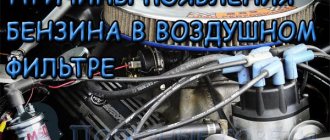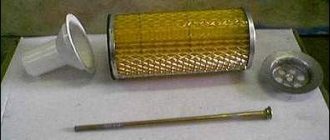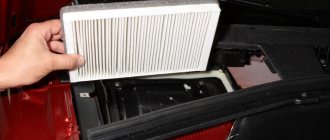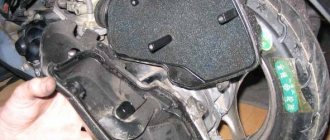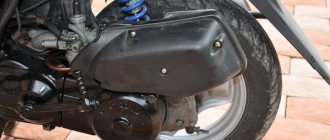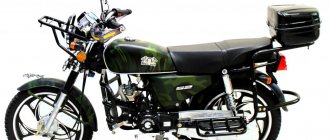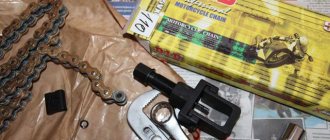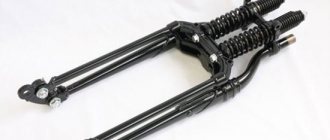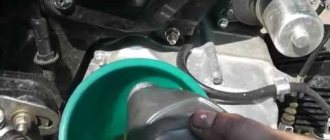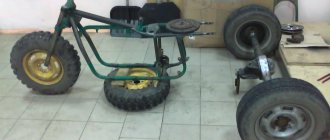Air filter functions
The function of a filter is to allow one substance to pass through and prevent another from entering. Accordingly, the job of the filter is to allow air into the carburetor, but to prevent the penetration of dust and large particles that enter the device along with the air. Another function of the air filter is to create air resistance. Such resistance is necessary for stable operation of two-stroke engines. On mopeds equipped with a four-stroke engine, air resistance reduces engine power, and accordingly, when it becomes clogged, the traction and speed characteristics of the moped decrease.
Signs that replacement is needed:
- The car consumes more combustible material;
- The engine picks up speed more slowly and is difficult to start;
- Exhaust emissions release more carbon dioxide;
- When visually examining the device, dirt, plaque, dust, small insects, etc. are visible.
Cleaning the foam filter
In short, let's get started. Let's start by removing the filter . Often, in order to reach the filter, you need to unscrew the seat and part of the plastic body kit. Before removing the filter cover, you need to make sure that there are no deposits of dirt, sand or dust in the filter housing that may have entered the intake distributor during dismantling. If there is, it needs to be cleaned before removing the filter. We remove the filter and look into the air intake. It's great if you can see the carburetor directly. We are looking for dust deposits and dark deposits on the carburetor diffuser, which indicate that the air is not being cleaned well.
At the next stage, after inspecting the intake tract, you should plug it with a rag (which does not leave lint and does not unravel into strings, well, it’s clean, of course) or a special lid. Since the next step in order will be cleaning the inside of the air filter housing, you need to be sure that nothing gets into the middle of the intake pipe. Why do you need to clean the air filter box? The cleaner it is, the slower the cleaned (new) filter will clog, and the box itself is also a good dust collector, especially if a crankcase exhaust is connected to it, due to which an oily deposit forms on the walls of the air filter housing. It would be advisable to clean all this with a cloth soaked in gasoline or white spirit. When working with white spirit and other solvents, it is good to use glasses, gloves and work in a well-ventilated area!
Now the fun part begins, which is actually cleaning and washing the removed foam filter .
There are a lot of specialized motorcycle chemicals for servicing filters, but a significant part of it is not approved for use in Europe due to toxicity and, accordingly, may not be officially supplied to our country. Some similar kits even come with a branded washing bucket, but considering the price products like this, I wouldn’t want to go bankrupt servicing the filter. But it needs to be serviced constantly, and no tuning bucket will reduce its dirtiness. That's why smart scooterists choose white spirit! It is prohibited to use gasoline, as there is a danger of affecting the glued seams of the air filter, and even more so, more aggressive solvents, which can directly turn foam rubber into glue, are not suitable. You need to purchase your own plastic bucket with a sealed lid and store a couple of liters of white spirit in it just for flushing purposes. This cleaning is rough and preliminary, so a couple of liters filled in is enough for repeated use.
You need to put something like a grate on the bottom of the bucket. This is so that the washed dirt particles quietly fall into the sediment and remain there without rising to the top, catching them with the filter when washing.
We immerse the filter in a bucket of white spirit and lightly “massage” it. We periodically pull it out, carefully squeezing it out (without fanaticism and without twisting it!), and examine it to make sure that there is less and less dirty oil.
After “rubbing” in white spirit has ceased to produce visible results in cleaning the filter, you need to carefully unscrew it and carefully check for ruptures, cuts and simply natural aging. If a tear in the filter cloth begins somewhere, even if it is not through, the filter must be replaced with a new one.
Filter selection
How to choose the right filter?
There are two types of cleaning mechanisms for the Alpha moped:
- standard cleaner;
- zero resistance filter.
The first provides basic filtration parameters and requires replacement after 1.5 thousand kilometers. The zero-resistance device is an idea that came from racing cars, where they use such filters or not use them at all to increase power. This increases engine power by 3-5 percent, but the engine loses protection from dust and dirt. Since sports cars with this type of cleaning device are used on special racing tracks, the amount of dirt and dust on the road there is kept to a minimum.
When using a zero-resistance filter on a moped, it will not provide a noticeable increase in power; the only visual difference will be the sound of operation (it will become more bassy). On the other hand, such a device does not protect the engine from small dust particles, so during its operation there is a possibility of rapid failure of the moped engine.
Alpha has a paper filter
Exactly. But you still need to clean it, and preferably more often. Gasoline is possible.
At the same time, you need to clean the carburetor.
Carb, air intake and air leaks are the first causes of loss of traction (personal experience), if this does not help then everything is much more complicated.
Guys! The paper filter is disposable! Treated by replacement
Paper gasoline filter????
It seemed to me that the paper one was coming off - put in a new one......
Actually, Alpha has a paper filter element ; it does not require as frequent maintenance as a foam one. I clean mine every 5000 km.
about the service life of paper and foam filters . Having learned from the bitter experience of the Honda filter (scooter), where you need to clean it every 500 km, I started cleaning mine at 1000 km. Just wasted my time. It was practically pristine, with a little poplar fluff sticking to it. And where would there be dirt if the air intake comes from the cleanest area of the moped - under the seat. This is not a scooter where the filter sucks up all the crap from the road. After that, I drove another 1,400 km, once I stopped by for reassurance - it was clean and damp. So, with a successful design and 5000, the foam filter can pass.
My engine runs best when the quality screw is fully tightened. when I unscrew it by 1 turn, maybe a little more, the engine speed drops by about 500 rpm, and then I can unscrew it even further, at least completely, the engine does not reduce speed. I haven’t tried driving with it unscrewed. What's the best way to drive? when it is completely twisted black appears on the candle. Today I completely cleaned the spark plug like new, I’ll go and check it tomorrow (with it turned out 1.5 rpm). By the way, my air filter is a nulevik, without foam rubber, made of some kind of hard felt felt, or something paper-like. the shape of a cut cone... maybe that’s why it’s like this?
Could it be that the air filter is not allowing enough air to pass through? It needs to be replaced if it is paper.
Try to remove it, if with the screw unscrewed 1.5 turns and without a filter it does not work better, then clean the carburetor, but if this does not help, then the ignition, but it is not regulated, maybe there is something wrong with the switch.
On the contrary, the air filter even flows very well, as if it were not there, I already removed it. and you can hear the air rushing through it, especially when you turn on the gas, the carb took everything apart cleanly, two screws lowered into the float chamber, the wire easily fits into them like the first string. they are clean. I’m wondering if they could have inserted the wrong quality screw by mistake? Or will another one not fit there?
I've had it rustling since birth, especially now when I start it cold and warm up. Do not pay attention. A rustle is not a grinding sound. The chain can make a rustling noise; in Zhiguli cars it also rustles. As for the dips, enrich the mixture. I turned the quality screw half a turn, and now we are not afraid of frost.
Due to zero resistance filters, piston wear increases. If the moped is used in rural areas or where there is a lot of dust, then it is not worth installing.
Nulevik is too risky. Engine protection too weak. Moreover,
You can drink some water. Personal opinion
As for me, a filter similar to that used on Honda scooters is the most reliable. I'm talking about impregnated foam rubber. Imagine the conditions in which it works, what it sucks from the road, and filters well. And now, if you move it under the saddle, where it is much cleaner, the period between cleanings increases almost 10 times. Look at the photo to see how this is solved on some models with a 139FMB engine. In the photo the filter is with the cover removed, air is taken from the rear chamber, from the cleanest area of the moped. The filter in the photo is after running 2000 km on dusty summer roads. It didn’t require cleaning, it even remained wet.
I bought myself a nulevik for 45 UAH and impregnation for 40 UAH at the market, and DED said that you can use oil and gasoline and drink the money
Water is unlikely to get under the seat. Until Macarena missed the mark, he stood more dangerously.
In the nulevik there is an iron mesh on the outside and inside, and between them there is a fine mesh very similar to paper, but also iron.
After installing the zero level, dips appeared at low levels, now I have corrected it and enriched the mixture.
The funny sound became louder, snuffling.
Regarding the throttle: there are two adjusting screws on the carburetor - one raises the throttle valve, the so-called. in common parlance, the idle speed, and the second one regulates the air intake from the filter to the carb. So, if you have this screw clamped, then the mixture is enriched with oxygen just a little, but with the damper closed, generally no! I wish I knew which one. you have a carb, otherwise there are so many different ones on all these motorcycles... And the gears... Until you break them in, start with the first one, get used to it - it’s easy with the second one! I just go: first - up to 2500 rpm, second, third - up to 3000-4000 , depending on the dynamics (that is, are you starting or just accelerating). For example: I can slowly drive in fourth at 2500 rpm (if less, I’ll strain the engine!) What are the gears for? The engine revved up!!! Therefore: the lower the gear, the fewer high (!!!) revs! And then your horse will serve you for a long time, faithfully! Well, that’s all in a nutshell, good luck!!!
You need to look at the carbon deposits on the spark plug after you have driven at least five kilometers in 4th gear at medium speeds. It is useless to look after the engine is idling - the spark plug is black. Links to carb adjustment have been posted many times before.
I struggled with my carburetor for a very long time. They were idling, consumption was up to 3 liters per 100 km. The warranty specialist looked and said “Bad gasoline.” I drained the gasoline, before refueling, unscrewed the tap from the tank, and poured all the residue onto the ground. I took the moped to a gas station and filled it up with a new one. This didn't help either. The specialist cleaned the carb again and started turning it. In short, after adjusting it, I had difficulty getting home. At home I removed the carb myself, cleaned everything, and blew out the channels. The result is zero. I decided to take it off and explore it completely. When reinstalling it, I broke it apart - I tightened one screw securing the carb to the pipe. The distance bar also burst. The next day I went to the market, bought a new carb, and had difficulty finding the spacer bar. Put. Adjusted according to the description. I DIDN'T RECOGNIZE MY HORSE!
Why didn't I break it on the first day?
Quality screw - WITHOUT SPRING , Idle screw WITH SPRING
How to change it correctly?
How to change the air filter on a Chinese moped? The sequence of actions for replacing the cleaning device in a moped is quite simple.
Instructions for DIY replacement steps:
- First of all, we install the moped on the stand. It is also advisable to wash the moped to prevent dirt from getting into the moped components;
- Now you can start replacing: remove the protective cover of the battery; to do this, you need to unscrew one bolt with a Phillips screwdriver;
- Then we disconnect the battery from the terminals and take it out of the seat;
- Next, you need to remove the seat; to do this, you need to unscrew two bolts with a “10” key and move it with a sharp movement (from left to right in the direction of travel of the moped);
- As soon as the seat has moved, we lift it and it can be easily removed. Pull the clamp off the air filter pipe. If yours is not rubber, but metal, you must first loosen it;
- Now you can pull the pipe off the carburetor. This must be done carefully to prevent dirt from getting inside the carburetor;
- After the pipe has been disconnected from the carburetor, we pull it inward to the place where the battery was. The air filter housing is made of rubberized material, so it can only be deformed when removed, only carefully. While deforming the filter housing, carefully pull it out. This should be done extremely carefully, as you can touch and break the wires passing nearby;
- After successfully removing the casing, remove the filter from it. If there is dust or dirt in the casing, it is necessary to wash and dry it;
- Now install the filter and reassemble in reverse order.
Before installing the seat and battery cover, make sure you have not cut or disconnected any wires during installation.
16.3. Scooter repair. Air filter - removal, washing and installation
16.3. Scooter repair. Air filter - removal, washing and installation
SERVICE FREQUENCY
It is recommended to carry out this operation every 5–6 thousand km of the scooter. Some scooter models use replaceable paper air filters.
REMOVAL
To make it easier to replace the air filter element, it is recommended to remove the side trim of the scooter (see p. 64 “Covering - removal and installation”).
1. Unscrew the bolts of the air filter housing cover.
2. Remove the cover and remove the foam filter element.
WASHING AND IMPREGNATION WITH OIL
1. We wash the foam filter element with water and a neutral detergent (washing powder, dishwashing detergent or a special composition for washing air filters) and leave it until completely dry in the air.
ATTENTION!
The filter element must not be dried using hot air (hair dryer, heaters, open flame).
2. In order to properly impregnate the filter element with oil, you can use a special preparation “impregnation for air filters”, packaged in aerosol cans. If this is not possible, we use the “classic” method:
3. Pour approximately 30–40 grams of motor oil into a plastic bag.
4. Place the filter element into the bag.
5. Tie it and knead it in your hands until the oil is completely absorbed into the filter element.
6. As a result, the filter element should be uniformly colored according to the color of the impregnation.
ATTENTION!
The optimal amount of impregnation for each specific filter element is individual. The basic rule for monitoring the correct impregnation is that oil should not drain from the filter element, and at the same time, there should be no dry spots left on it. The entire surface of the element must be evenly saturated with oil.
We install the filter element in the reverse order.
ATTENTION!
Before installing the filter element, thoroughly clean the inside surface of the filter housing.
16.4. Scooter repair. Fuel filter - replacement.
SERVICE FREQUENCY
On most models of modern scooters with a four-stroke engine or a two-stroke engine with a separate lubrication system, a fuel filter is installed in the power system. It is needed in order to protect the carburetor and the cylinder-piston group of the engine from the ingress of fine dust and other particles that have entered the fuel. It is recommended to replace the filter once every 10 thousand km, or after parking the scooter for a long time. The fuel filter is located in the gap in the gas tank-carburetor line and is often dismountable, which allows it to be cleaned without replacing the filter element.
REMOVAL
1. Loosen the fastening clamps on the fuel hoses.
2. To avoid fuel spilling from the line, place a rag under the filter and remove it.
INSTALLATION
We install a new fuel filter in the fuel line.
ATTENTION!
There is an arrow on the filter housing indicating the direction of fuel flow. When installing, observe the direction “towards the carburetor”.
Consequences of untimely replacement
If you don't change your air filter, at best its performance will deteriorate over time. The moped will lose power and stop idling. Also, dust getting into the carburetor will clog all the channels, which will lead to unstable operation. The worst case scenario may be that dirt gets into the engine itself. Large particles will leave deep scratches on the cylinder bore and on the piston. The valve assembly may fail. Accordingly, a major overhaul of the engine will be required, so you should not neglect replacing the air filter. The consequences can be dire.
Air filter functions
The function of a filter is to allow one substance to pass through and not even allow another to penetrate. Accordingly, the job of the filter is to allow air into the carburetor, but to prevent the penetration of dust and large particles that enter the device along with the air. Another function of the air filter
is to create air resistance. Such resistance is necessary for the smooth operation of two-stroke engines. On mopeds equipped with a four-stroke engine, air resistance reduces the power of the motor, and accordingly, when it becomes clogged, the traction and speed properties of the moped decrease.
Signs that replacement is needed:
- A car consumes more than just combustible material;
- The engine develops more slowly and is difficult to start;
- Exhaust emissions produce more than just carbon dioxide;
- When visually examining the device, dirt, plaque, dust, small insects, etc. are visible.
How to clean the air filter on a scooter
So, you have removed the foam filter element of the scooter and determined that there is no obvious damage.
Proper washing can only be done in gasoline or regular warm water using detergents (dishwashing liquid or washing powder). Now you can also buy a special product for washing foam air filters.
Filter selection
How to choose the right filter?
There are two types of cleaning mechanisms for the Alpha moped:
- standard cleaner;
- zero resistance filter .
The first provides basic filtration characteristics and requires replacement after 1.5 thousand km. The zero-resistance device is an idea that came from sports cars, where to increase power they use such filters. They don’t use it at all. This increases engine power by 3-5 percent, but the engine loses protection from dust and dirt. Because sports cars with this type of cleaning device are used on special racing tracks, the amount of dirt and dust on the road there is reduced to nothing.
Scooter air filter lubrication
Then it needs to be lubricated. Manuals for old scooters recommend using engine or transmission oil for impregnation, but the disadvantage of this approach is that such oil is quite fluid and after some time collects at the bottom of the filter. But the air goes through the upper section. The thicker the oil, the more suitable it is for impregnation.
Special impregnations for filters , which are sold in the form of sprays, contain, if you take it apart, the lubricant itself and a thinner, which after applying the lubricant evaporates within 15 minutes. Before installation, wait fifteen minutes to give the volatile components time to evaporate. Since this lubricant does not penetrate deep into the filter, it traps dust even worse. And last on the list are specialized liquid oils, which are sold in regular bottles without pressure. Absolutely all professional oils are painted in bright colors, so that the stage and uniformity of impregnation can be assessed by the color of the filter. Liqui Moly Racing Luft-Filter-Oil is specifically blue, but it also comes in red and green.
There is no need to completely dip the filter into the grease. Apply the oil little by little, kneading the filter in your hands to speed up the penetration of the oil throughout the entire volume of the filter. Add oils to empty areas. There is no need to achieve perfect oil coverage of the filter by all means; most likely, this can only be achieved by excessive impregnation, which is also not good. As an option, take a plastic bag and pour the required amount of oil into it (approximately 3-5 caps), place the filter in a package, tie the bag and, squeezing it with massage movements, distribute the lubricant over the surface. With some skill it turns out instantly and correctly, the filter is ready for use. Again, you need to specially anoint the areas where the foam rubber adheres to the air filter body to ensure tightness.
For long trips, you should stock up on a set of several already impregnated filters (they take up a little space). And if you serve, then everyone is free at the same time.
Alfa moped air filter replacement
I don’t know about others, but for me the most unpleasant thing about servicing an alpha moped
This is a replacement
for the air
filter.
When using a zero-resistance filter on a moped, it will not provide a noticeable increase in power; the only visual difference will be the sound of operation (it will become more bassy). On the other hand, such a device does not protect the engine from small dust particles, so during its operation there is a possibility of rapid failure of the moped engine.
How to change it correctly?
How to change the air filter
on a Chinese moped? The sequence of actions for replacing the cleaning device in a moped is quite simple.
Instructions for DIY replacement steps:
- First of all, we install the moped on the stand. It is also advisable to wash the moped to prevent dirt from getting into the moped components;
- Now you can start replacing: remove the protective cover of the battery; to do this, you need to unscrew one bolt with a Phillips screwdriver;
- Then we disconnect the battery from the terminals and take it out of the seat;
- Next, you need to remove the seat; to do this, you need to unscrew two bolts with a “10” key and move it with a sharp movement (from left to right in the direction of travel of the moped);
- As soon as the seat has moved, we lift it and it can be easily removed. Pull the clamp off the air filter pipe. If yours is not rubber, but metal, you must first loosen it;
- Now you can pull the pipe off the carburetor. This must be done carefully to prevent dirt from getting inside the carburetor;
- After the pipe has been disconnected from the carburetor, we pull it inward to the place where the battery was. The air filter housing is made of rubberized material, so it can only be deformed when removed, only carefully. While deforming the filter housing, carefully pull it out. This should be done extremely carefully, as you can touch and break the wires passing nearby;
- After successfully removing the casing, remove the filter from it. If there is dust or dirt in the casing, it is necessary to wash and dry it;
- Now install the filter and reassemble in reverse order.
Consequences of untimely replacement
If you don't change your air filter, at best its performance will deteriorate over time. The moped will lose power and stop idling. Also, dust getting into the carburetor will clog all the channels, which will lead to unstable operation. The worst case scenario may be that dirt gets into the engine itself. Large particles will leave deep scratches on the cylinder bore and on the piston. The valve assembly may fail. Accordingly, a major overhaul of the engine will be required, so you should not neglect replacing the air filter. The consequences can be dire.
The frequency of replacement depends on the level of road pollution in the area. The cleaning system should be carefully inspected periodically.
Scooters and mopeds are equipped with an internal combustion engine. Therefore, many basic principles and rules for servicing components of gasoline engines of passenger cars also apply to them. In particular, this applies to the air filter of scooters.
When to clean or replace the filter
Scooter air filters serve to clean the air entering the carburetor and then into the engine as part of the fuel mixture. The filter element of a moped performs the same function. The consequences of untimely replacement or cleaning of them can be no less disastrous than with the wrong approach to this issue in relation to automobile air filters. In any case, the owner of a scooter or moped will start filling up more gasoline and will be annoyed that his iron friend has become sluggish and no longer accelerates to the km/h required by the passport.
Manufacturers recommend replacing the air filter of a scooter or moped at least every 5,000 km, and cleaning it after every 1,000 km.
If the scooter or moped is used in very dusty roads or terrain, then maintenance and replacement should be carried out more often. In this case, cleaning should be performed at least every 500 km traveled, and, in order to prevent premature engine wear, you can start with a test inspection and cleaning (if necessary) of the filter after the first 100 km. Based on the results of this check, it will be clear whether it makes sense to service the filter element every 100 km or whether the mileage before the next cleaning should be increased. When the time comes to change the filter altogether, it will be clear either by its appearance or by the behavior of the scooter or moped engine - after the next filter maintenance, symptoms will remain that it is clogged and the motor does not have enough air for it to work.
How to remove the air filter on a scooter for maintenance or replacement
Let's look at how to properly remove the scooter air filter
for further cleaning or replacement:
- We place the scooter on the central support.
- Let's see if the side plastic of the scooter interferes with the comfortable removal of the filter box cover. If it interferes, it is better to remove the side plastic.
- We unscrew the screws securing the filter box lid and place it in a separate container.
- Remove the cover.
- Carefully remove the filter element (foam rubber, paper or combination). We inspect the filter; if there is any damage to the foam, its peeling or other deformations, the element must be replaced. If there is no visible damage, we proceed to clean it.
How to remove and replace the air filter of a scooter or moped
The engines of most scooters and mopeds have a “wet” type filter (on almost all Chinese vehicles) or a “dry” type filter (mainly on Japanese ones). “Wet” is made of oil- and petrol-resistant foam rubber and impregnated with a special oil that ensures the retention of small particles. The filter itself consists of two layers:
- internal, having a fine-mesh structure - to retain the smallest contaminants;
- external, with larger cells - for filtering large particles.
